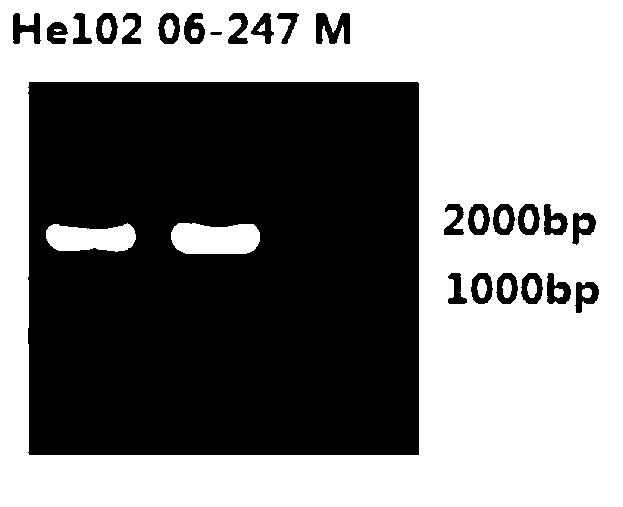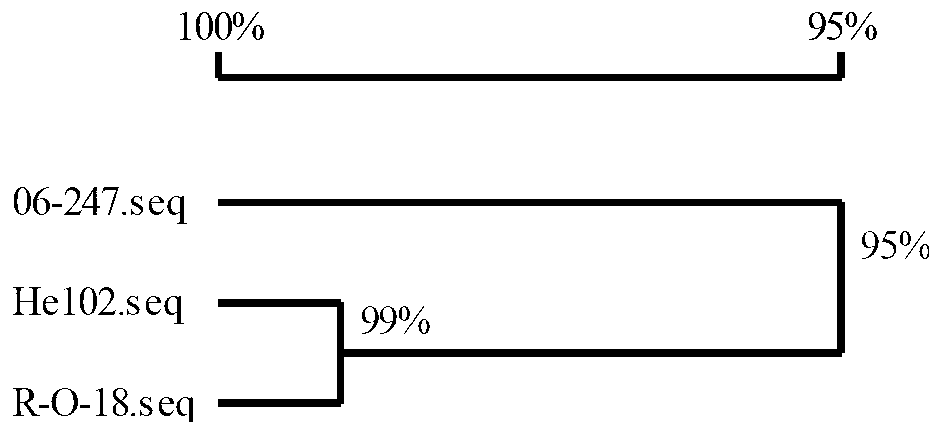Molecular markers for distinguishing two new haplotypes of Brassica rapaL. ssp pekinensis eIF4E.c and application thereof
An eif4e.c, haplotype technology, applied in the determination/inspection of microorganisms, DNA/RNA fragments, recombinant DNA technology, etc., to achieve the effect of improving screening efficiency, stable results, and easy operation
- Summary
- Abstract
- Description
- Claims
- Application Information
AI Technical Summary
Problems solved by technology
Method used
Image
Examples
Embodiment 1
[0033] Example 1. Cloning of eIF4E.c in different Chinese cabbage inbred lines
[0034] 1.1 Chinese cabbage genomic DNA extraction
[0035] (1) Put the leaves of Chinese cabbage seedlings into a liquid nitrogen pre-cooled mortar, and grind them into powder in liquid nitrogen;
[0036] (2) After the liquid nitrogen evaporates to dryness, transfer it to a 2ml centrifuge tube immediately, add about 0.6ml of CTAB extract preheated to 65°C for every 100mg of material, after melting, vigorously shake and mix the sample, place it in a 65°C water bath for 40- 60 minutes to lyse the cells;
[0037] (3) After the lysis is complete, take out the sample and let it cool down to room temperature completely. Add an equal volume of chloroform (chloroform), gently invert to mix, and place at room temperature for 10 minutes;
[0038] (4) Centrifuge at 12000 rpm for 15 minutes at room temperature;
[0039] (5) Use a pipette to carefully suck out the upper aqueous phase, add it to a new 1.5ml...
Embodiment 2
[0057] Example 2 Development of co-dominant ASM markers
[0058] 2.1 Primer design
[0059] Careful comparison of the two haplotypes of eIF4E.c Hap r and Hap s The difference in the genome sequence is mainly in the InDels in the intron region. In view of this difference, two sets of primers Fd1 and Rd1, Fd2 and Rd2 were designed in the conserved region upstream of the deletion region, and they were commissioned by Huada Gene Co., Ltd. to synthesize them.
[0060] 2.2 Acquisition of ASM mark
[0061] The differential region was amplified by nested PCR technique:
[0062] (1) Use the outer primer combination Fd1 and Rd1 to amplify He102 and 06-247 genomic DNA, and cycle 20 times; use the first PCR product as a template, use the inner primer combination Fd2 and Rd2 to perform the second PCR amplification, and the reaction solution The preparation and amplification conditions are as described in Section 1.2 (2).
[0063] (2) The amplification results were detected by electrop...
Embodiment 3
[0065] Example 3 Identification of Individual Plants in Callback Population (He102×06-247)×06-247 by ASM Markers
[0066] (1) The genomic DNA of different individual plants of the callback population was extracted as described in 1.1.
[0067] (2) PCR amplification: The preparation and amplification conditions of the PCR reaction solution are as described in item (2) of 1.2.
[0068] (3) Detection of PCR products is as described in item (3) of 1.2. Test results such as Figure 4 As shown, P1 and P2 are the parents 06-247 and He102, respectively, and 1-23 are 23 Chinese cabbage materials. In the figure, individual plants 11, 12, 21, and 22 are the haplotypes in the parent P1, namely 06-247, and individual plants 2, 4, 5, 6, 14, and 18 are the haplotypes in the parent P2, namely He102. strains are heterozygous.
[0069]
[0070]
[0071]
[0072]
[0073]
PUM
 Login to View More
Login to View More Abstract
Description
Claims
Application Information
 Login to View More
Login to View More - R&D
- Intellectual Property
- Life Sciences
- Materials
- Tech Scout
- Unparalleled Data Quality
- Higher Quality Content
- 60% Fewer Hallucinations
Browse by: Latest US Patents, China's latest patents, Technical Efficacy Thesaurus, Application Domain, Technology Topic, Popular Technical Reports.
© 2025 PatSnap. All rights reserved.Legal|Privacy policy|Modern Slavery Act Transparency Statement|Sitemap|About US| Contact US: help@patsnap.com



